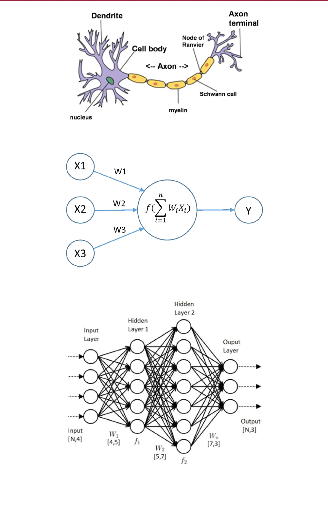1.1.1 What is learning
Learning is the process of gaining knowledge or skill.
2
1.1 Machine Learning

Definition 1.2
?
Learning is the performance's improvement in a particular
task with respect to experiance.
1.1.2 Categories of learning
There are three main types of machine learning:
Index Task Explanation
|
1 Supervised
Learning
|
it consists of an outcome predicted from a given set of
independent variables,we us these variables to create a function that best fit
the given
data ,we keep on modifying the function until it reaches the
desired.
Hierarchical clustering
K-means clustering [10]
|
|
2 Unsupervised
Learning
|
in this algorithm there is no outcome ,it is used for
clustering data based. Examples for unsupervised learning :apriori
algorithm,k-means etc
Reinforcement Learning: the machine is trained to make a
certain decision by being exposed to the environment and learn from past
experiences [10].
|
|
3 Reinforcement
Learning
|
In reinforcement learning, an agent interacts with its
environment and periodically receives awards that reflect how well it is doing
at its task. Reinforcement learning is distinct from "just solving a Markov
decision process (MDP)" since the MDP is not presented to the agent as a
problem to solve; the agent is in the MDP. It does not know the model of
transformation or the reward mechanism, and to learn more [10].
|
Table 1.1: Types of learning
1.1.3 Limitations
Machine learning is notorious for it'difficult features
extraction part, in machine learning that'usually done by the designer ,another
limitation would be the inability to create complex patterns for complex data
patterns,deep learning solve this two fatal flaws.
1.1.4 Deep Learning
Inspired by how the human brain works, tried to reverse engineer
the neurons 1.1 in our central nervous system led to the creation of artificial
neuron 1.2 ,stacking this neurons together allows the mapping of more complex
data also called Artificial Neural networks (ANN) [8] 1.3.
1.1 Machine Learning

Figure 1.1: neuron / Source[26]
Figure 1.2: artificial neuron / Source[18]
Figure 1.3: artificial neural network /
Source[2]
3
4
1.1 Machine Learning
as illustrated in the figure 1.2 there is a main processing
part named neuron that takes an input X1,X2,X3...Xn do a processing and fires
an output Y ,this is similar to what happens inside our brains. stacking this
neurons together forms a network that we can divide into three main parts:
1.1.4.1 Deep Neural Concepts
Index Concept Explanation
1 Activation Function also known as transfer learning,a function
that takes the weighted sum
and produced on outcome based on the nature of the function [8]:
linear activation function
non linear activation function
2 Error functions a function used for the task of evaluating the
network performance ,a
measure of how wrong the network is [8].
3 Optimization in the learning process optimization algorithms
are used to minimize
algorithms the error by finding the optimal weights.
4 Batch a way of making networks faster by re-scaling the data
,giving a mean
Normalization of zero and a standard deviation of one [8].
5 Dropout turning off a percentage of the neurons that make up
certain layers during
a particular forward or backward pass, it is used to prevent
over-fitting [8].
Table 1.2: Deep Learning Concepts
| 


